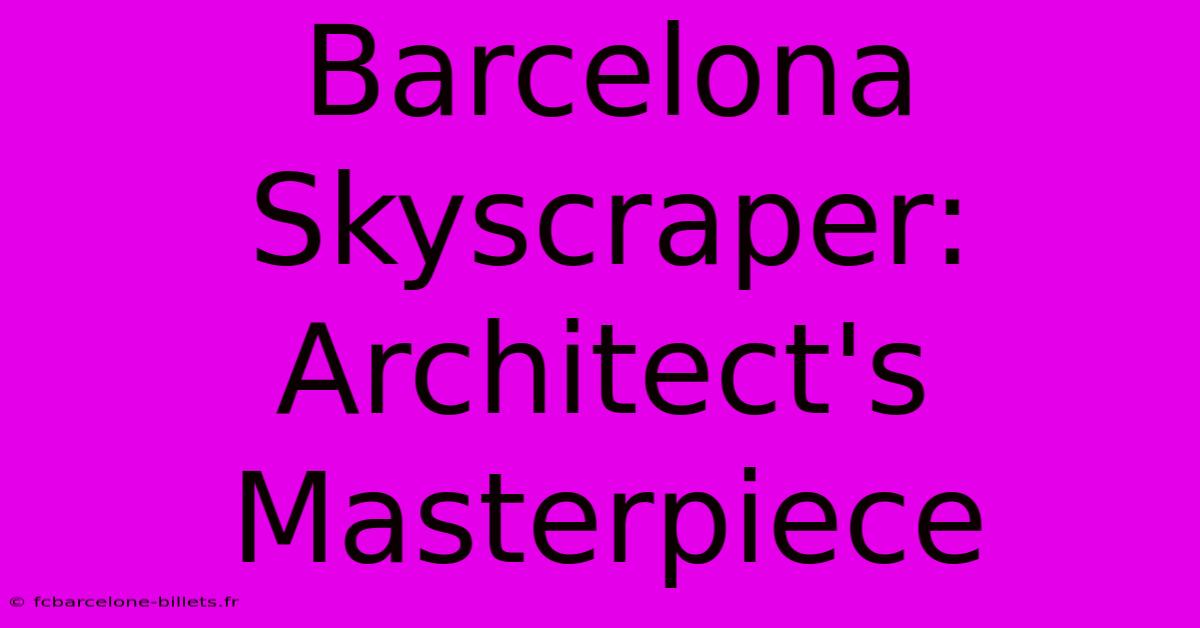Barcelona Skyscraper: Architect's Masterpiece

Table of Contents
Barcelona Skyscraper: Architect's Masterpiece
Barcelona, a city renowned for its Gaudi-inspired architecture and vibrant culture, is experiencing a subtle shift. While its low-rise, charming streets remain iconic, a new generation of skyscrapers is pushing the city's skyline towards the future. This article delves into the fascinating world of Barcelona's burgeoning skyscraper scene, focusing on the architectural masterpieces that are reshaping the city's silhouette and examining the impact of these towering structures on the urban landscape.
The Rise of the Barcelona Skyscraper: A Modern Architectural Movement
For years, Barcelona's building codes and a strong preservationist ethos limited high-rise construction. However, a combination of factors – including increasing population density, a thriving economy, and a desire to compete with other European capitals – has led to a gradual acceptance of taller buildings. This isn't a haphazard surge; rather, it's a deliberate effort to integrate modern architectural principles with the city's unique character. The result? Skyscrapers that are not just tall but also aesthetically pleasing and environmentally conscious.
Key Characteristics of Barcelona's Modern Skyscrapers:
- Sustainable Design: Many new skyscrapers incorporate green building technologies, aiming for LEED certification or similar sustainability standards. This includes features like solar panels, rainwater harvesting systems, and energy-efficient materials.
- Innovative Aesthetics: The designs move beyond simple glass towers. Architects are experimenting with unique forms, incorporating local materials, and reflecting the city's artistic heritage in their creations. We see curves, unusual angles, and the incorporation of balconies and terraces – a nod to Barcelona's traditional architecture.
- Integration with the Urban Fabric: Unlike some cities where skyscrapers stand in stark contrast to their surroundings, Barcelona's new high-rises are thoughtfully integrated into the existing urban fabric. They're often designed to complement nearby buildings and green spaces, minimizing visual disruption.
Notable Examples of Barcelona Skyscrapers: Architectural Gems
While a definitive list requires continuous updating as new projects emerge, some buildings already stand out as exemplary examples of Barcelona's evolving architectural landscape. These structures exemplify the blend of modern innovation and respect for the city's heritage:
- [Insert Name of a Specific Skyscraper Here, with brief description, focusing on architectural style, sustainable features, and its impact on the neighborhood.] For example: "The Torre Glòries, formerly known as the Agbar Tower, is a striking example of modern architecture. Its unique, undulating form, inspired by a geyser, is instantly recognizable. Its sustainable design includes features like rainwater collection and efficient air conditioning."
- [Insert Name of another Specific Skyscraper Here, with brief description, focusing on architectural style, sustainable features, and its impact on the neighborhood.] For instance: "The Hotel Arts Barcelona showcases a sleek, contemporary design with its glass facade reflecting the Mediterranean light. Its prime location along the beachfront offers spectacular views."
The Future of Barcelona's Skyline: A Balancing Act
The construction of skyscrapers in Barcelona represents a delicate balancing act. It's a challenge to reconcile the need for modern development with the preservation of the city's unique character and historical significance. However, the current trend suggests a successful approach. By emphasizing sustainable practices, innovative design, and careful integration with the urban environment, Barcelona is creating a skyline that is both impressive and respectful of its rich heritage.
Challenges and Opportunities:
- Preservation of Historical Views: Careful planning and height restrictions are crucial to prevent new buildings from obstructing iconic views of Barcelona's historical landmarks.
- Public Access and Amenities: New skyscrapers often incorporate public spaces and amenities, such as plazas, green areas, and observation decks, to benefit the entire community.
- Addressing Potential Negative Impacts: Developers and planners must address potential concerns related to traffic congestion, shadowing, and environmental impacts.
Conclusion:
Barcelona's skyscrapers are more than just tall buildings; they're a testament to the city's dynamic spirit and its ability to blend modernity with tradition. As the city continues to evolve, we can expect to see even more innovative and sustainable high-rise structures that contribute to Barcelona's ever-changing and captivating skyline. The architectural masterpieces currently rising showcase a future where sustainability and aesthetic excellence go hand in hand, shaping a cityscape that is both modern and deeply rooted in its unique cultural identity.

Thank you for visiting our website wich cover about Barcelona Skyscraper: Architect's Masterpiece. We hope the information provided has been useful to you. Feel free to contact us if you have any questions or need further assistance. See you next time and dont miss to bookmark.
Featured Posts
-
The Ultimate Iberian Rail Experience Barcelona To Porto
Apr 02, 2025
-
Barcelona Venues For Corporate Events
Apr 02, 2025
-
Barcelona Gay Beach Let Your Hair Down
Apr 02, 2025
-
Cava Bar Barcelona Drink Dine And Delight
Apr 02, 2025
-
Elegant Transfers Barcelona Airport To Port
Apr 02, 2025
